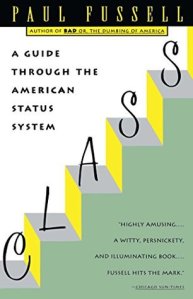Title: Class: A Guide Through the American Status System
Author: Paul Fussell
Genre: Sociology
Trigger Warnings: Classism, sexual terminology
Back Cover:
The bestselling, comprehensive, and carefully researched guide to the ins-and-outs of the American class system with a detailed look at the defining factors of each group, from customs to fashion to housing.
Based on careful research and told with grace and wit, Paul Fessell shows how everything people within American society do, say, and own reflects their social status. Detailing the lifestyles of each class, from the way they dress and where they live to their education and hobbies, Class is sure to entertain, enlighten, and occasionally enrage readers as they identify their own place in society and see how the other half lives.
Review:
I expected a lot more social justice out of this, and that’s not what I got at all. This is more in the line of David Brooks (or perhaps I should say David Brooks is in the line of this, since this book was published well before Brooks’ works) – a work of sociology and observation.
And classism. Paul obviously is (or thinks he is) one of the upper classes in his nine-class system, because the writing is full of snobbery and disdain. Sure, the phenomena he describes are interesting, but any time he discusses anyone below upper-middle class, you can practically see him turning up his nose and saying “and this is what the lower classes do” with a disdainful sniff.
It’s even hard for me to determine what is actually accurate about his observations, because this book was published in the early nineties. So much has changed in technology and society since Class was published that quite a bit of what Paul talks about doesn’t apply to anyone anymore. I think my parents are upper middle by his definitions, but it’s hard to tell. When I tried the judgement scale based on what’s in their living room, Paul had me subtract two class points for not having visible ashtrays.
Some of it actually was interesting, though. A couple chapters (notably the one on dressing habits) helped me pinpoint some of the subconscious details you pick up on to judge a person’s class. And even though it was hard to tell what was relevant when it came to media and home decor and the like, it was still an interesting (if not completely relevant) look at class indicators in the 80s/early 90s.
Class was not what I had expected or hoped for, and Paul is insufferably snobby, but I wouldn’t say the book was bad. Irrelevant, maybe; classist, definitely; but at least entertaining to read.

